BMP3004 World of Work: Analyzing Factors of Employee Motivation
VerifiedAdded on 2023/06/18
|8
|2085
|85
Report
AI Summary
This report provides an understanding of employee motivation in the workplace, emphasizing its importance in achieving organizational goals. It explores the concept of motivation, differentiating between intrinsic and extrinsic factors and linking them to Maslow's hierarchy of needs. The report identifies key factors that motivate employees, such as salary, promotion opportunities, and a positive work environment. It also discusses the positive factors employees experience, including development opportunities and a sense of belonging, alongside negative factors like workplace conflicts and inappropriate working conditions. Furthermore, it outlines strategies to mitigate negative factors, such as fostering employee engagement, promoting a learning culture, and creating a supportive environment where concerns are addressed effectively. The report concludes that understanding and addressing employee motivation is crucial for organizational success and long-term sustainability in a competitive market. Desklib offers this assignment solution along with a wide array of study resources, including past papers, to support students in their academic endeavors.
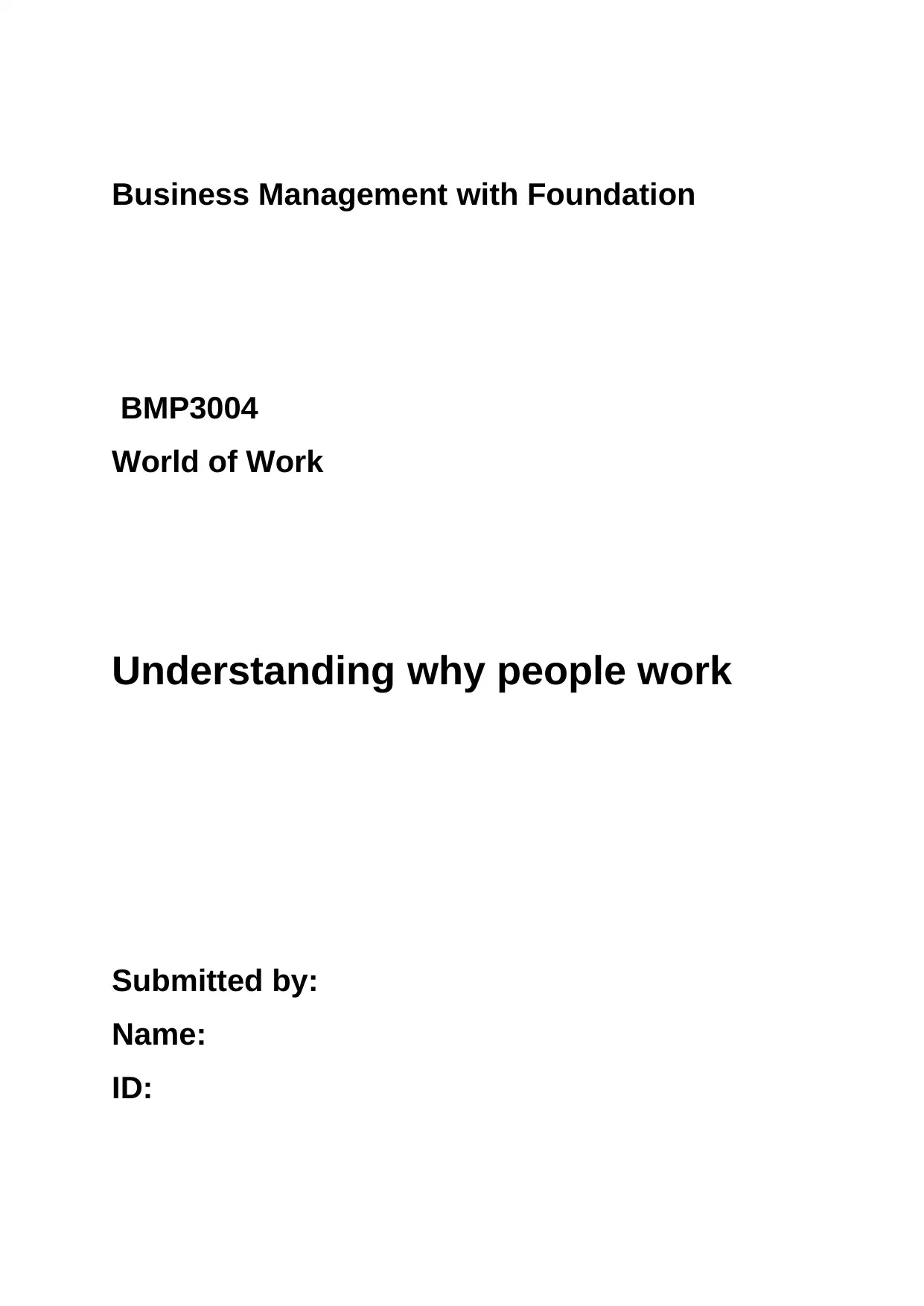
Business Management with Foundation
BMP3004
World of Work
Understanding why people work
Submitted by:
Name:
ID:
BMP3004
World of Work
Understanding why people work
Submitted by:
Name:
ID:
Paraphrase This Document
Need a fresh take? Get an instant paraphrase of this document with our AI Paraphraser
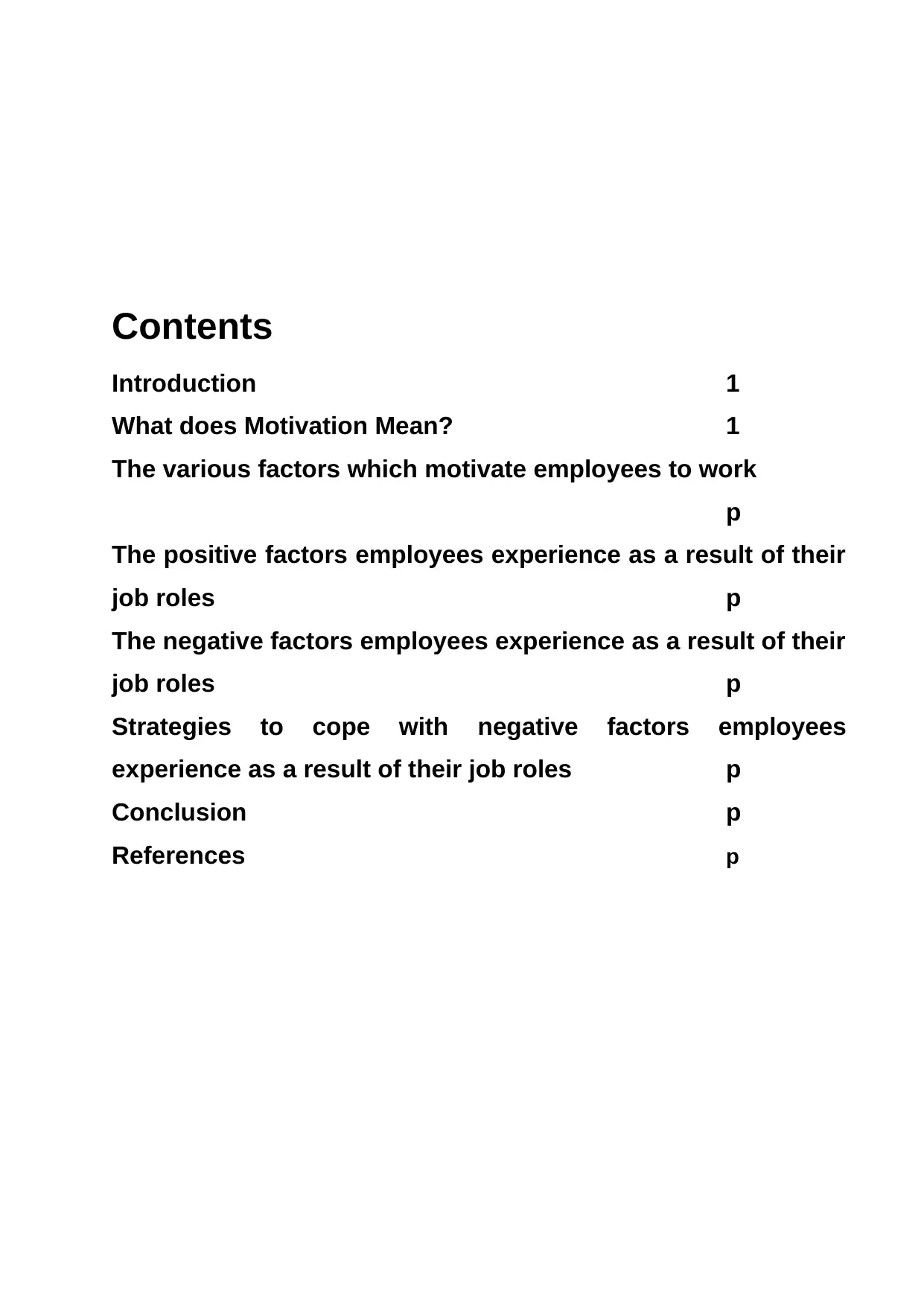
Contents
Introduction 1
What does Motivation Mean? 1
The various factors which motivate employees to work
p
The positive factors employees experience as a result of their
job roles p
The negative factors employees experience as a result of their
job roles p
Strategies to cope with negative factors employees
experience as a result of their job roles p
Conclusion p
References p
Introduction 1
What does Motivation Mean? 1
The various factors which motivate employees to work
p
The positive factors employees experience as a result of their
job roles p
The negative factors employees experience as a result of their
job roles p
Strategies to cope with negative factors employees
experience as a result of their job roles p
Conclusion p
References p
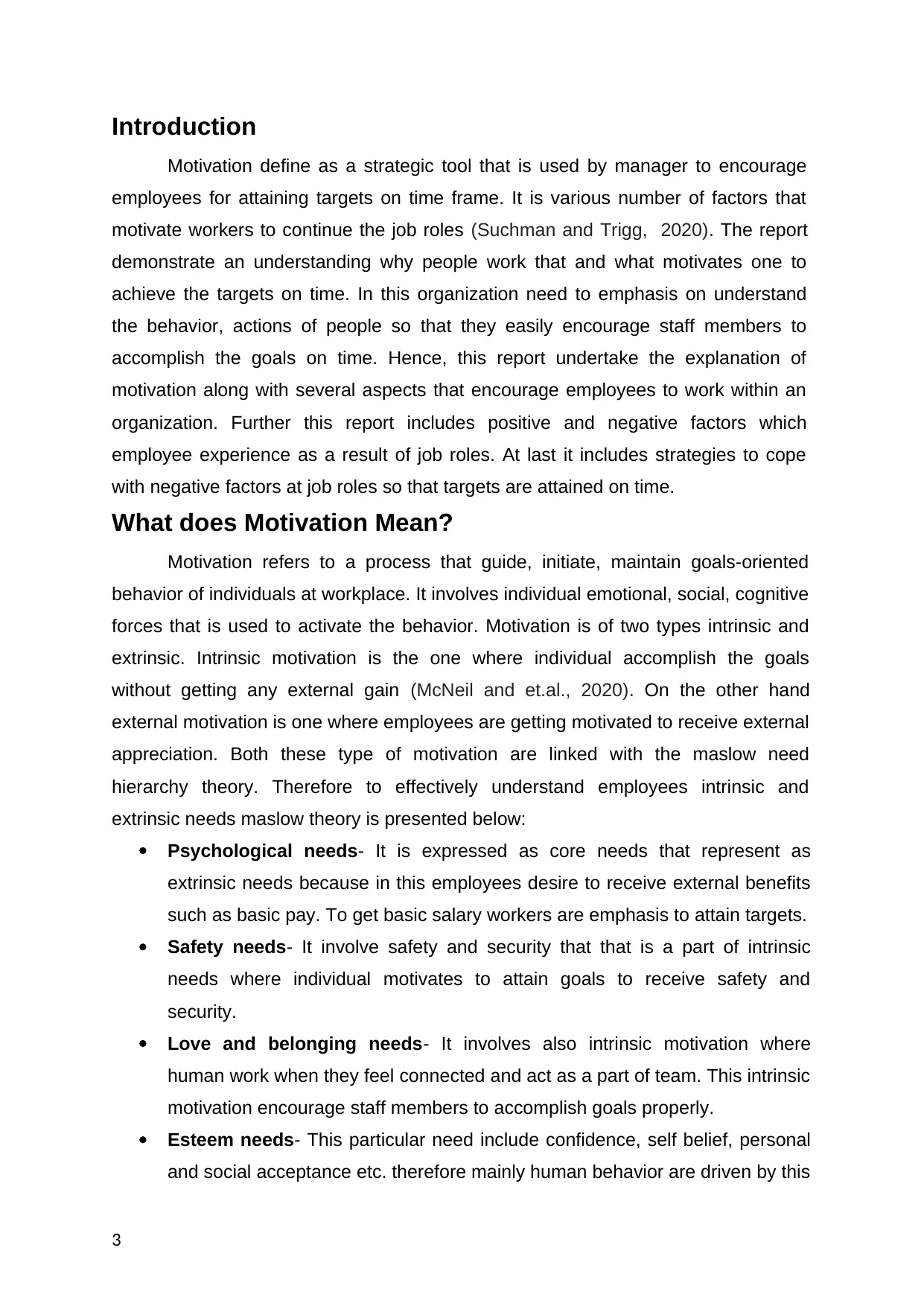
Introduction
Motivation define as a strategic tool that is used by manager to encourage
employees for attaining targets on time frame. It is various number of factors that
motivate workers to continue the job roles (Suchman and Trigg, 2020). The report
demonstrate an understanding why people work that and what motivates one to
achieve the targets on time. In this organization need to emphasis on understand
the behavior, actions of people so that they easily encourage staff members to
accomplish the goals on time. Hence, this report undertake the explanation of
motivation along with several aspects that encourage employees to work within an
organization. Further this report includes positive and negative factors which
employee experience as a result of job roles. At last it includes strategies to cope
with negative factors at job roles so that targets are attained on time.
What does Motivation Mean?
Motivation refers to a process that guide, initiate, maintain goals-oriented
behavior of individuals at workplace. It involves individual emotional, social, cognitive
forces that is used to activate the behavior. Motivation is of two types intrinsic and
extrinsic. Intrinsic motivation is the one where individual accomplish the goals
without getting any external gain (McNeil and et.al., 2020). On the other hand
external motivation is one where employees are getting motivated to receive external
appreciation. Both these type of motivation are linked with the maslow need
hierarchy theory. Therefore to effectively understand employees intrinsic and
extrinsic needs maslow theory is presented below:
Psychological needs- It is expressed as core needs that represent as
extrinsic needs because in this employees desire to receive external benefits
such as basic pay. To get basic salary workers are emphasis to attain targets.
Safety needs- It involve safety and security that that is a part of intrinsic
needs where individual motivates to attain goals to receive safety and
security.
Love and belonging needs- It involves also intrinsic motivation where
human work when they feel connected and act as a part of team. This intrinsic
motivation encourage staff members to accomplish goals properly.
Esteem needs- This particular need include confidence, self belief, personal
and social acceptance etc. therefore mainly human behavior are driven by this
3
Motivation define as a strategic tool that is used by manager to encourage
employees for attaining targets on time frame. It is various number of factors that
motivate workers to continue the job roles (Suchman and Trigg, 2020). The report
demonstrate an understanding why people work that and what motivates one to
achieve the targets on time. In this organization need to emphasis on understand
the behavior, actions of people so that they easily encourage staff members to
accomplish the goals on time. Hence, this report undertake the explanation of
motivation along with several aspects that encourage employees to work within an
organization. Further this report includes positive and negative factors which
employee experience as a result of job roles. At last it includes strategies to cope
with negative factors at job roles so that targets are attained on time.
What does Motivation Mean?
Motivation refers to a process that guide, initiate, maintain goals-oriented
behavior of individuals at workplace. It involves individual emotional, social, cognitive
forces that is used to activate the behavior. Motivation is of two types intrinsic and
extrinsic. Intrinsic motivation is the one where individual accomplish the goals
without getting any external gain (McNeil and et.al., 2020). On the other hand
external motivation is one where employees are getting motivated to receive external
appreciation. Both these type of motivation are linked with the maslow need
hierarchy theory. Therefore to effectively understand employees intrinsic and
extrinsic needs maslow theory is presented below:
Psychological needs- It is expressed as core needs that represent as
extrinsic needs because in this employees desire to receive external benefits
such as basic pay. To get basic salary workers are emphasis to attain targets.
Safety needs- It involve safety and security that that is a part of intrinsic
needs where individual motivates to attain goals to receive safety and
security.
Love and belonging needs- It involves also intrinsic motivation where
human work when they feel connected and act as a part of team. This intrinsic
motivation encourage staff members to accomplish goals properly.
Esteem needs- This particular need include confidence, self belief, personal
and social acceptance etc. therefore mainly human behavior are driven by this
3
⊘ This is a preview!⊘
Do you want full access?
Subscribe today to unlock all pages.

Trusted by 1+ million students worldwide

needs where they receive personal importance. This help employees to reach
goals within organization.
Self actualization needs- This need is crucial to motivate employees towards
goals achievements and build high reputation within society. It is a type of
intrinsic development of individual human that helps them to reach the
potential.
The various factors which motivate employees to work
There are variety of factors which encourage staff members towards goals
achievements and accomplish targets that manager assigned to them (Lynn, 2019).
Several factors that actually motivate workers to work are presented below:
Salary: It is core need that encourages employees to work properly. When
employees receives salary on time than they work with full efforts and passion.
Hence, it basically present as a psychological need where manager influence
workers by giving them proper pay so that employees complete their basic
requirements to live. This actually motivate employees to work.
Promotion: In an organization, if employees are not getting promotion
then it create high risk for company in survival (Murnieks, Klotz, Shepherd, 2020).
Therefore, promotion is actually important factor that motivate employees to perform
task appropriately. For example- IMO electronics manager initiate to promote those
employees who work effectively and accomplish targets on set time frame. Hence, it
represent as extrinsic motivation and expressed maslow esteem need. By receiving
promotion employees get respect at workplace that is fully intrinsic and helps to
attain targets on time within organization.
Work Environment: To motivate employees towards working, working
environment is essential factor. It relates to physical and non-physical environment.
To work within a business enterprise clean and hygiene environment is very
important for employees so that they present creative ideas to complete the
objectives of time. For example- IMO is a organization that offer open space to their
workers so that they perform goals effectively and efficiently. Hence, this factor
highly motivate workers to work and helps organization to generate profitable results
at marketplace.
4
goals within organization.
Self actualization needs- This need is crucial to motivate employees towards
goals achievements and build high reputation within society. It is a type of
intrinsic development of individual human that helps them to reach the
potential.
The various factors which motivate employees to work
There are variety of factors which encourage staff members towards goals
achievements and accomplish targets that manager assigned to them (Lynn, 2019).
Several factors that actually motivate workers to work are presented below:
Salary: It is core need that encourages employees to work properly. When
employees receives salary on time than they work with full efforts and passion.
Hence, it basically present as a psychological need where manager influence
workers by giving them proper pay so that employees complete their basic
requirements to live. This actually motivate employees to work.
Promotion: In an organization, if employees are not getting promotion
then it create high risk for company in survival (Murnieks, Klotz, Shepherd, 2020).
Therefore, promotion is actually important factor that motivate employees to perform
task appropriately. For example- IMO electronics manager initiate to promote those
employees who work effectively and accomplish targets on set time frame. Hence, it
represent as extrinsic motivation and expressed maslow esteem need. By receiving
promotion employees get respect at workplace that is fully intrinsic and helps to
attain targets on time within organization.
Work Environment: To motivate employees towards working, working
environment is essential factor. It relates to physical and non-physical environment.
To work within a business enterprise clean and hygiene environment is very
important for employees so that they present creative ideas to complete the
objectives of time. For example- IMO is a organization that offer open space to their
workers so that they perform goals effectively and efficiently. Hence, this factor
highly motivate workers to work and helps organization to generate profitable results
at marketplace.
4
Paraphrase This Document
Need a fresh take? Get an instant paraphrase of this document with our AI Paraphraser
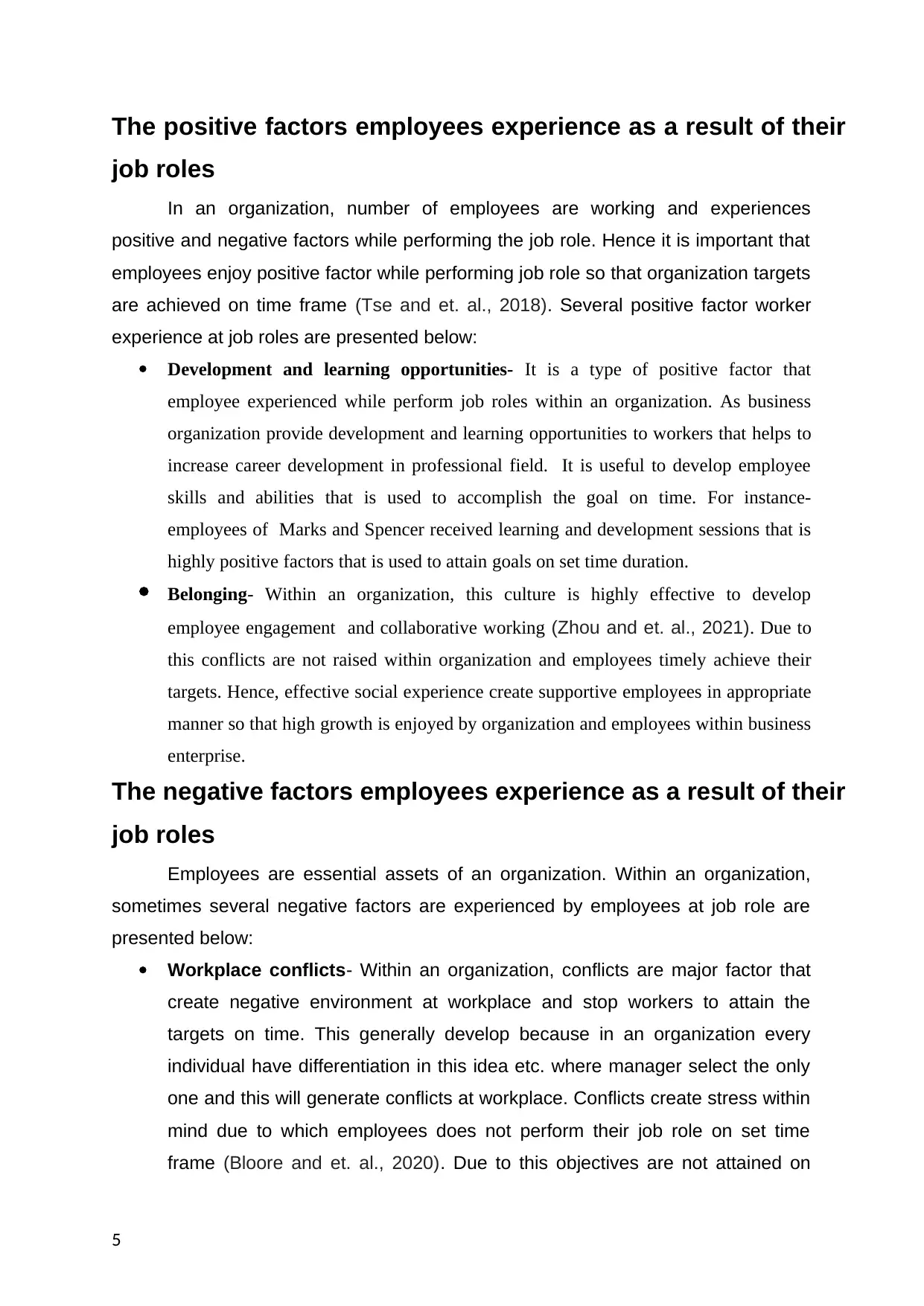
The positive factors employees experience as a result of their
job roles
In an organization, number of employees are working and experiences
positive and negative factors while performing the job role. Hence it is important that
employees enjoy positive factor while performing job role so that organization targets
are achieved on time frame (Tse and et. al., 2018). Several positive factor worker
experience at job roles are presented below:
Development and learning opportunities- It is a type of positive factor that
employee experienced while perform job roles within an organization. As business
organization provide development and learning opportunities to workers that helps to
increase career development in professional field. It is useful to develop employee
skills and abilities that is used to accomplish the goal on time. For instance-
employees of Marks and Spencer received learning and development sessions that is
highly positive factors that is used to attain goals on set time duration.
Belonging- Within an organization, this culture is highly effective to develop
employee engagement and collaborative working (Zhou and et. al., 2021). Due to
this conflicts are not raised within organization and employees timely achieve their
targets. Hence, effective social experience create supportive employees in appropriate
manner so that high growth is enjoyed by organization and employees within business
enterprise.
The negative factors employees experience as a result of their
job roles
Employees are essential assets of an organization. Within an organization,
sometimes several negative factors are experienced by employees at job role are
presented below:
Workplace conflicts- Within an organization, conflicts are major factor that
create negative environment at workplace and stop workers to attain the
targets on time. This generally develop because in an organization every
individual have differentiation in this idea etc. where manager select the only
one and this will generate conflicts at workplace. Conflicts create stress within
mind due to which employees does not perform their job role on set time
frame (Bloore and et. al., 2020). Due to this objectives are not attained on
5
job roles
In an organization, number of employees are working and experiences
positive and negative factors while performing the job role. Hence it is important that
employees enjoy positive factor while performing job role so that organization targets
are achieved on time frame (Tse and et. al., 2018). Several positive factor worker
experience at job roles are presented below:
Development and learning opportunities- It is a type of positive factor that
employee experienced while perform job roles within an organization. As business
organization provide development and learning opportunities to workers that helps to
increase career development in professional field. It is useful to develop employee
skills and abilities that is used to accomplish the goal on time. For instance-
employees of Marks and Spencer received learning and development sessions that is
highly positive factors that is used to attain goals on set time duration.
Belonging- Within an organization, this culture is highly effective to develop
employee engagement and collaborative working (Zhou and et. al., 2021). Due to
this conflicts are not raised within organization and employees timely achieve their
targets. Hence, effective social experience create supportive employees in appropriate
manner so that high growth is enjoyed by organization and employees within business
enterprise.
The negative factors employees experience as a result of their
job roles
Employees are essential assets of an organization. Within an organization,
sometimes several negative factors are experienced by employees at job role are
presented below:
Workplace conflicts- Within an organization, conflicts are major factor that
create negative environment at workplace and stop workers to attain the
targets on time. This generally develop because in an organization every
individual have differentiation in this idea etc. where manager select the only
one and this will generate conflicts at workplace. Conflicts create stress within
mind due to which employees does not perform their job role on set time
frame (Bloore and et. al., 2020). Due to this objectives are not attained on
5
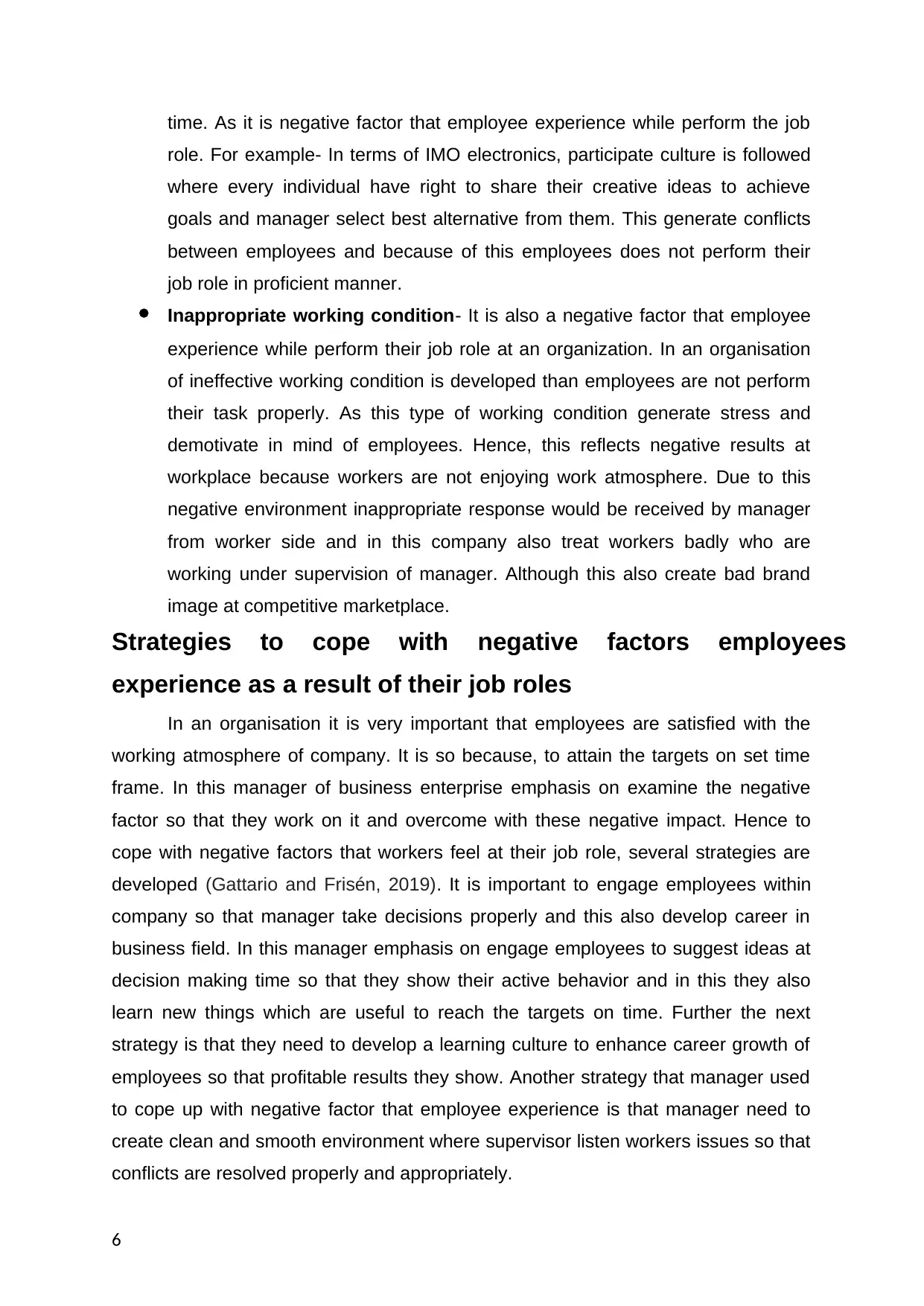
time. As it is negative factor that employee experience while perform the job
role. For example- In terms of IMO electronics, participate culture is followed
where every individual have right to share their creative ideas to achieve
goals and manager select best alternative from them. This generate conflicts
between employees and because of this employees does not perform their
job role in proficient manner.
Inappropriate working condition- It is also a negative factor that employee
experience while perform their job role at an organization. In an organisation
of ineffective working condition is developed than employees are not perform
their task properly. As this type of working condition generate stress and
demotivate in mind of employees. Hence, this reflects negative results at
workplace because workers are not enjoying work atmosphere. Due to this
negative environment inappropriate response would be received by manager
from worker side and in this company also treat workers badly who are
working under supervision of manager. Although this also create bad brand
image at competitive marketplace.
Strategies to cope with negative factors employees
experience as a result of their job roles
In an organisation it is very important that employees are satisfied with the
working atmosphere of company. It is so because, to attain the targets on set time
frame. In this manager of business enterprise emphasis on examine the negative
factor so that they work on it and overcome with these negative impact. Hence to
cope with negative factors that workers feel at their job role, several strategies are
developed (Gattario and Frisén, 2019). It is important to engage employees within
company so that manager take decisions properly and this also develop career in
business field. In this manager emphasis on engage employees to suggest ideas at
decision making time so that they show their active behavior and in this they also
learn new things which are useful to reach the targets on time. Further the next
strategy is that they need to develop a learning culture to enhance career growth of
employees so that profitable results they show. Another strategy that manager used
to cope up with negative factor that employee experience is that manager need to
create clean and smooth environment where supervisor listen workers issues so that
conflicts are resolved properly and appropriately.
6
role. For example- In terms of IMO electronics, participate culture is followed
where every individual have right to share their creative ideas to achieve
goals and manager select best alternative from them. This generate conflicts
between employees and because of this employees does not perform their
job role in proficient manner.
Inappropriate working condition- It is also a negative factor that employee
experience while perform their job role at an organization. In an organisation
of ineffective working condition is developed than employees are not perform
their task properly. As this type of working condition generate stress and
demotivate in mind of employees. Hence, this reflects negative results at
workplace because workers are not enjoying work atmosphere. Due to this
negative environment inappropriate response would be received by manager
from worker side and in this company also treat workers badly who are
working under supervision of manager. Although this also create bad brand
image at competitive marketplace.
Strategies to cope with negative factors employees
experience as a result of their job roles
In an organisation it is very important that employees are satisfied with the
working atmosphere of company. It is so because, to attain the targets on set time
frame. In this manager of business enterprise emphasis on examine the negative
factor so that they work on it and overcome with these negative impact. Hence to
cope with negative factors that workers feel at their job role, several strategies are
developed (Gattario and Frisén, 2019). It is important to engage employees within
company so that manager take decisions properly and this also develop career in
business field. In this manager emphasis on engage employees to suggest ideas at
decision making time so that they show their active behavior and in this they also
learn new things which are useful to reach the targets on time. Further the next
strategy is that they need to develop a learning culture to enhance career growth of
employees so that profitable results they show. Another strategy that manager used
to cope up with negative factor that employee experience is that manager need to
create clean and smooth environment where supervisor listen workers issues so that
conflicts are resolved properly and appropriately.
6
⊘ This is a preview!⊘
Do you want full access?
Subscribe today to unlock all pages.

Trusted by 1+ million students worldwide
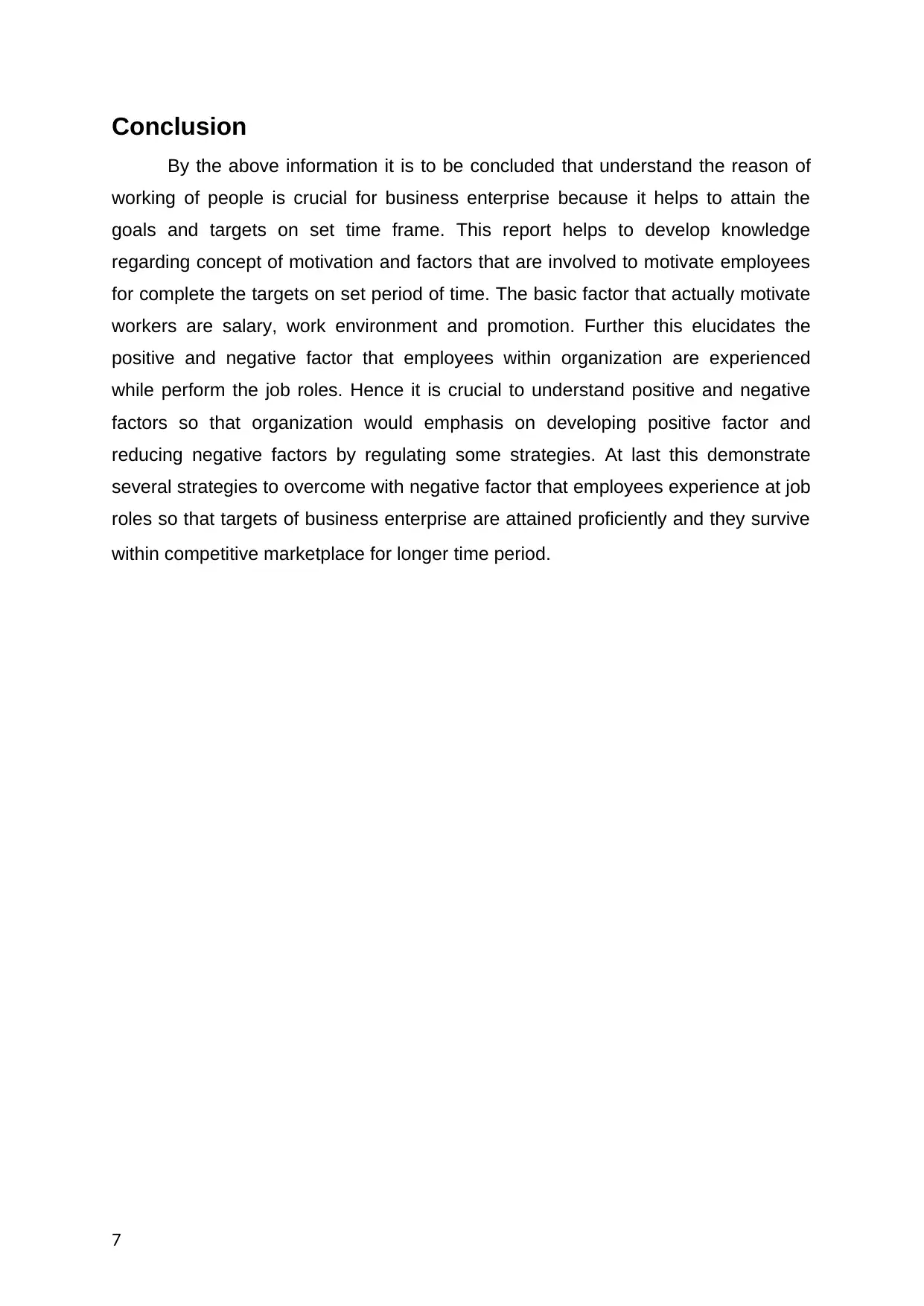
Conclusion
By the above information it is to be concluded that understand the reason of
working of people is crucial for business enterprise because it helps to attain the
goals and targets on set time frame. This report helps to develop knowledge
regarding concept of motivation and factors that are involved to motivate employees
for complete the targets on set period of time. The basic factor that actually motivate
workers are salary, work environment and promotion. Further this elucidates the
positive and negative factor that employees within organization are experienced
while perform the job roles. Hence it is crucial to understand positive and negative
factors so that organization would emphasis on developing positive factor and
reducing negative factors by regulating some strategies. At last this demonstrate
several strategies to overcome with negative factor that employees experience at job
roles so that targets of business enterprise are attained proficiently and they survive
within competitive marketplace for longer time period.
7
By the above information it is to be concluded that understand the reason of
working of people is crucial for business enterprise because it helps to attain the
goals and targets on set time frame. This report helps to develop knowledge
regarding concept of motivation and factors that are involved to motivate employees
for complete the targets on set period of time. The basic factor that actually motivate
workers are salary, work environment and promotion. Further this elucidates the
positive and negative factor that employees within organization are experienced
while perform the job roles. Hence it is crucial to understand positive and negative
factors so that organization would emphasis on developing positive factor and
reducing negative factors by regulating some strategies. At last this demonstrate
several strategies to overcome with negative factor that employees experience at job
roles so that targets of business enterprise are attained proficiently and they survive
within competitive marketplace for longer time period.
7
Paraphrase This Document
Need a fresh take? Get an instant paraphrase of this document with our AI Paraphraser
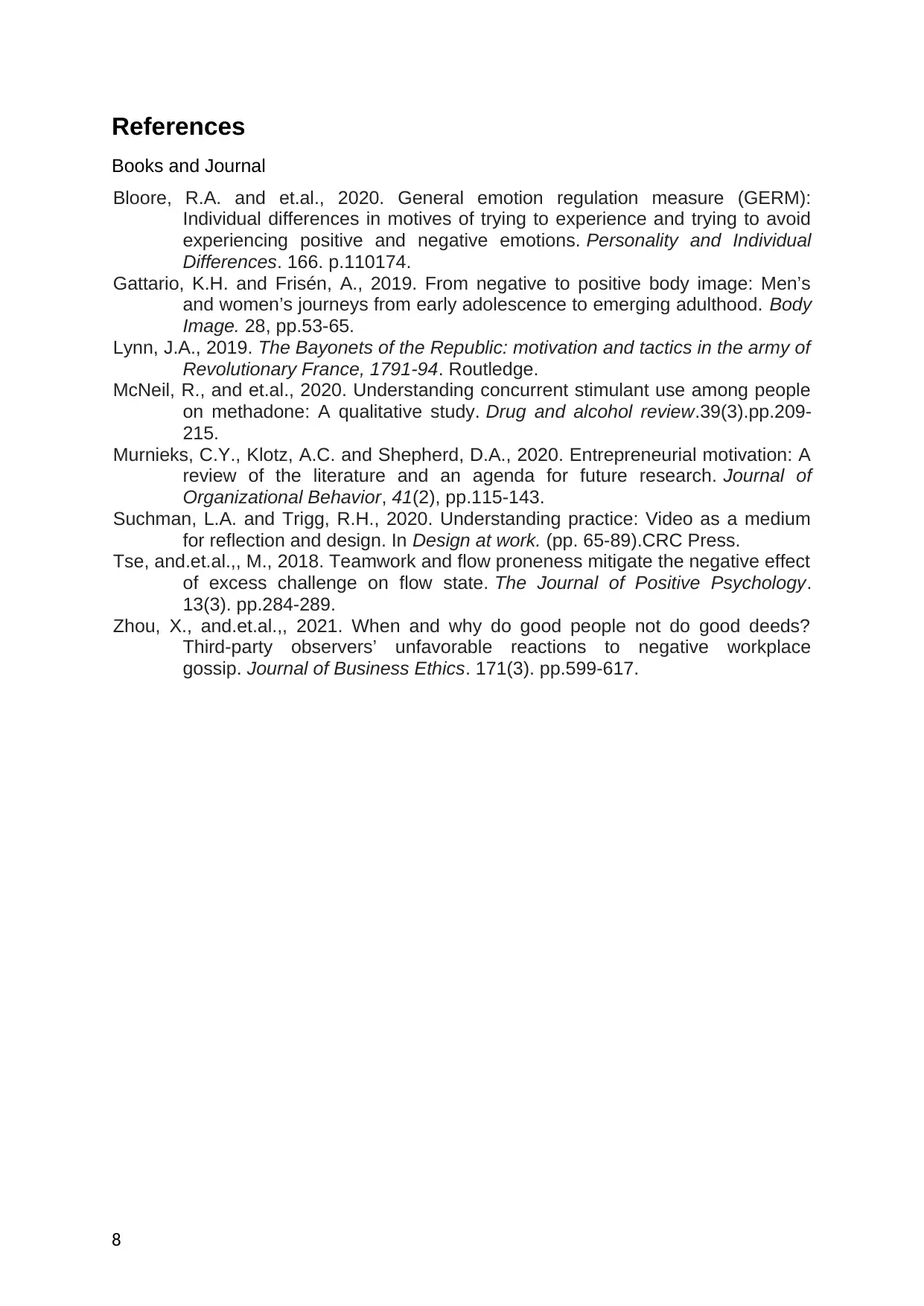
References
Books and Journal
Bloore, R.A. and et.al., 2020. General emotion regulation measure (GERM):
Individual differences in motives of trying to experience and trying to avoid
experiencing positive and negative emotions. Personality and Individual
Differences. 166. p.110174.
Gattario, K.H. and Frisén, A., 2019. From negative to positive body image: Men’s
and women’s journeys from early adolescence to emerging adulthood. Body
Image. 28, pp.53-65.
Lynn, J.A., 2019. The Bayonets of the Republic: motivation and tactics in the army of
Revolutionary France, 1791-94. Routledge.
McNeil, R., and et.al., 2020. Understanding concurrent stimulant use among people
on methadone: A qualitative study. Drug and alcohol review.39(3).pp.209-
215.
Murnieks, C.Y., Klotz, A.C. and Shepherd, D.A., 2020. Entrepreneurial motivation: A
review of the literature and an agenda for future research. Journal of
Organizational Behavior, 41(2), pp.115-143.
Suchman, L.A. and Trigg, R.H., 2020. Understanding practice: Video as a medium
for reflection and design. In Design at work. (pp. 65-89).CRC Press.
Tse, and.et.al.,, M., 2018. Teamwork and flow proneness mitigate the negative effect
of excess challenge on flow state. The Journal of Positive Psychology.
13(3). pp.284-289.
Zhou, X., and.et.al.,, 2021. When and why do good people not do good deeds?
Third-party observers’ unfavorable reactions to negative workplace
gossip. Journal of Business Ethics. 171(3). pp.599-617.
8
Books and Journal
Bloore, R.A. and et.al., 2020. General emotion regulation measure (GERM):
Individual differences in motives of trying to experience and trying to avoid
experiencing positive and negative emotions. Personality and Individual
Differences. 166. p.110174.
Gattario, K.H. and Frisén, A., 2019. From negative to positive body image: Men’s
and women’s journeys from early adolescence to emerging adulthood. Body
Image. 28, pp.53-65.
Lynn, J.A., 2019. The Bayonets of the Republic: motivation and tactics in the army of
Revolutionary France, 1791-94. Routledge.
McNeil, R., and et.al., 2020. Understanding concurrent stimulant use among people
on methadone: A qualitative study. Drug and alcohol review.39(3).pp.209-
215.
Murnieks, C.Y., Klotz, A.C. and Shepherd, D.A., 2020. Entrepreneurial motivation: A
review of the literature and an agenda for future research. Journal of
Organizational Behavior, 41(2), pp.115-143.
Suchman, L.A. and Trigg, R.H., 2020. Understanding practice: Video as a medium
for reflection and design. In Design at work. (pp. 65-89).CRC Press.
Tse, and.et.al.,, M., 2018. Teamwork and flow proneness mitigate the negative effect
of excess challenge on flow state. The Journal of Positive Psychology.
13(3). pp.284-289.
Zhou, X., and.et.al.,, 2021. When and why do good people not do good deeds?
Third-party observers’ unfavorable reactions to negative workplace
gossip. Journal of Business Ethics. 171(3). pp.599-617.
8
1 out of 8
Related Documents
Your All-in-One AI-Powered Toolkit for Academic Success.
+13062052269
info@desklib.com
Available 24*7 on WhatsApp / Email
![[object Object]](/_next/static/media/star-bottom.7253800d.svg)
Unlock your academic potential
Copyright © 2020–2025 A2Z Services. All Rights Reserved. Developed and managed by ZUCOL.

